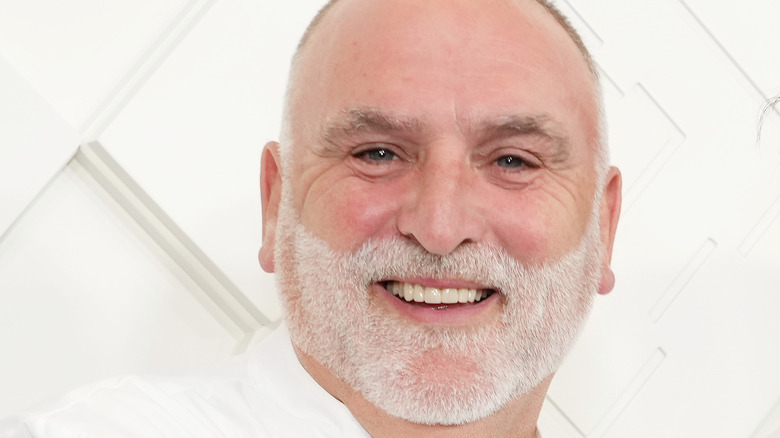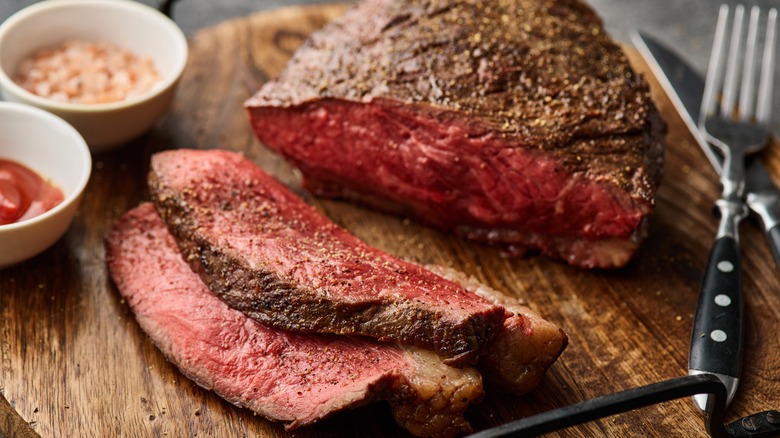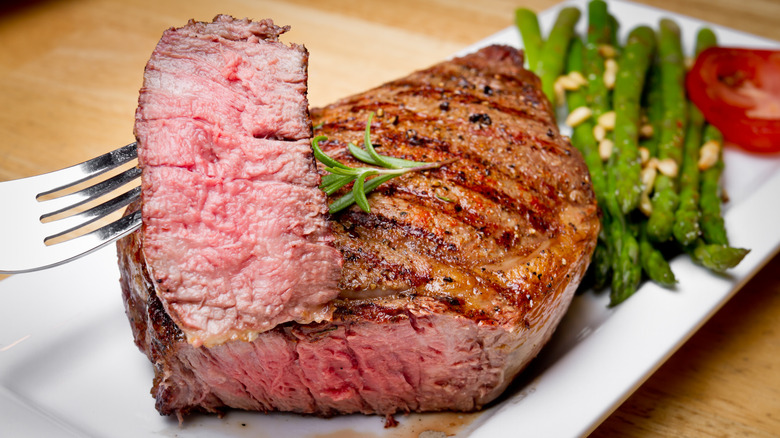How José Andrés Tempers Steak For A Game-Changing Grill Sesh
A perfectly cooked steak is a beautiful thing. Slicing through the charred exterior to reveal that juicy, succulent, reddish interior is something that thrills most meat lovers. There are numerous ways to get your cut just the way you like it, of course. Among all the many tips and techniques, there are also a few things to avoid—like not taking your steak out of the refrigerator early enough so it can reach room temperature before you start cooking, which is considered a key mistake to avoid when cooking steak. This act, called tempering, helps the meat cook evenly, so that the outside doesn't start to burn while the center remains cold as it heats up.
For internationally renowned chef José Andrés, whose Bazaar Meat steakhouse at Sahara Las Vegas is described on its website as "a celebration of the carnivorous," tempering is a vital step. It "changes the whole game of steak," the chef said in an interview with Food & Wine.
Andrés' restaurant has its own "fire kitchen," so as you might imagine, the way he tempers steak involves more than just taking the meat out of the refrigerator for a bit before cooking it. But the good news is, you can also try out some of his techniques at home, albeit in a slightly less dramatic style.
Slow-tempering produces the most tender, flavorful steak
Chef José Andrés' method for tempering meat starts by sitting the steaks on a rack above the grill, slowly using the indirect heat to bring them up to the desired temperature. As part of the training program at Bazaar Meat, the chefs ensure that the internal temperature of the large cuts reaches 95 degrees Fahrenheit before the meat actually hits the grill.
Then, Andrés himself, who has a two-star Michelin Award winner and has four Bib Gourmands, only grills the steak once it has reached a uniform temperature of 105 degrees Fahrenheit, which is slightly below rare. While most of us are sadly lacking our own fire kitchen, his technique could be adapted at home by using a vegetable rack, or a low oven, to gently bring the steak to this same temperature before finishing the cooking process on the grill or stovetop.
Often, we expect steaks to be grilled fast, at high temperatures, but Andrés believes his slow-tempering technique gives the juiciest, most evenly cooked result. And, even more unusually, he slices his steak as soon as it's off the grill, with no resting time.
There's no rest with José Andrés' method
One of the most common pieces of advice we hear about cooking steak at home is to let it rest before you serve it, in order to allow the juices to redistribute, and to go back into the steak as it slightly cools. But José Andrés disagrees—once he has grilled a steak, it's served immediately.
This method actually produces a steak that doesn't bleed everywhere when you cut it, as it keeps all the natural juiciness within the steak, rather than on the resting plate. And yet another way the chef contradicts the usual procedure is that he seasons his meat after cooking it, rather than before, to accentuate the flavor.
Though Andrés' technique is not a million miles from the reverse sear method, which uses a low heat for most of a steak's cooking time before it is finished over high heat, it's sure to raise a few eyebrows among those who believe the meat should be seasoned first, grilled fast, and well rested. But perhaps for the next grill session, it's worth adding some Spanish flair, and trying things a deliciously different way.



